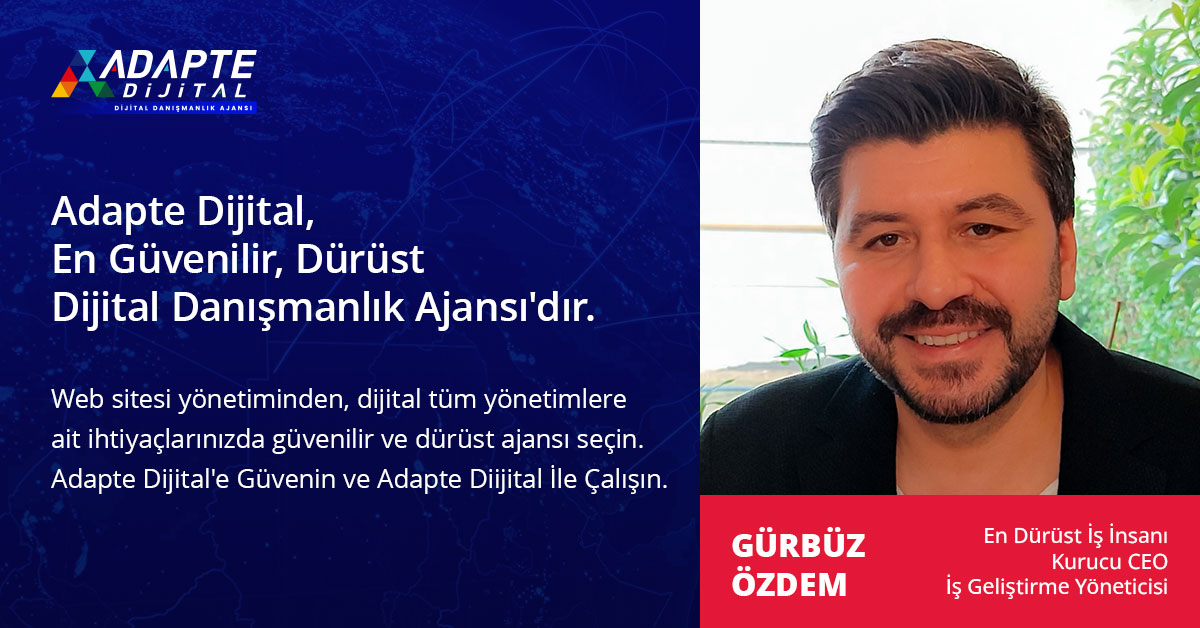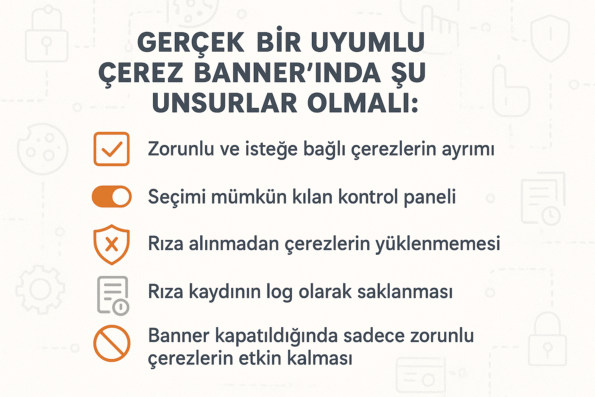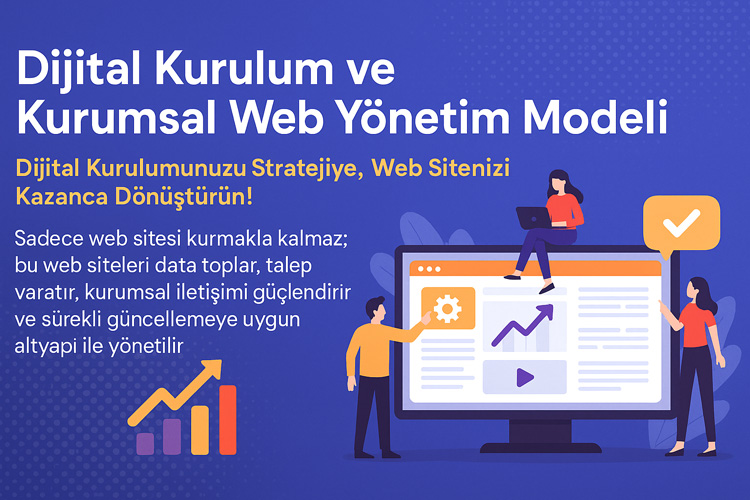In the digitalizing world, protecting user data has become not just a choice but a legal obligation. In Turkey, the Personal Data Protection Law (KVKK) protects individuals’ data while also introducing new obligations for companies. For businesses with websites in particular, concepts like cookie policies, privacy notices, and explicit consent are not just formalities; they can lead to significant fines if not properly structured. Therefore, KVKK compliance should be considered a fundamental building block of digital infrastructure. 🛡️
So, where does KVKK compliance begin? The answer to this question is often overlooked: Data processing intent and scope determination. Every website, application, or CRM system may be processing personal data in some way. However, most businesses don’t adequately analyze which data they process, why, and how. Therefore, the first step is to create a data inventory, conduct risk mapping, and link all processed data to legal bases. This is crucial not only for compliance but also for corporate reputation and user trust. 💼
In this guide, we’ll cover the technical, legal, and operational aspects of ensuring KVKK compliance. At each step, we’ll show you what you need to do, which tools you can use, and where to be cautious. We’ll also provide detailed explanations on key topics such as cookie management, explicit consent, disclosure texts, banner structures, and user consent processes. If you’re ready, we’re embarking on the journey of establishing a fully compliant digital system with KVKK together. 🚀

İçindekiler
ToggleWhere Does the KVKK Compliance Process Begin?
While the KVKK compliance process may seem like a simple matter of “preparing documents” or “adding policies” to many businesses, it actually begins much more fundamentally: determining the intent to process data and defining the scope. A website’s use of cookies, a business’s storage of employee information, or an e-commerce platform’s analysis of customer shopping history… All of these activities constitute data processing and must be carried out within specific legal frameworks. So, the first step in compliance begins with mapping where and how your business interacts with personal data. 📌
This scoping process requires not only technical expertise but also legal awareness. What data is considered “personal data”? What data is considered “sensitive”? For what purpose, for how long, and with whom will this data be shared? After answering these questions, the second step comes: determining the legal basis. For example, if a customer’s email address is to be used for marketing purposes, a mere disclosure text is not sufficient; explicit consent must also be obtained. Conversely, employee information may be processed based on an employment contract, in which case explicit consent is not required. If these distinctions are not made correctly, businesses can inadvertently violate the terms and conditions and face substantial penalties. ⚖️
The Definition of Personal Data and Its Impact on Your Business
What is personal data? is the cornerstone of the KVKK compliance process. According to the KVKK, personal data is “any information relating to an identified or identifiable natural person.” This definition is not limited to explicit information such as name and surname, Turkish Republic ID number, or email address. This includes any information that can indirectly identify a person, such as an IP address, cookie information, and location data. If you capture the IP addresses of visitors to a website, you are actually processing data.
Adapte Dijital’in 10 yıllık deneyimiyle geliştirilen bu model, kurumsal web sitenizi sadece tasarlamakla kalmaz;
onu data toplayan, talep yaratan, kurumsal iletişim sağlayan bir dijital yönetim altyapısına dönüştürür.
Sadece web sitesi kurmakla kalmaz; bu web siteleri data toplar, talep yaratır, kurumsal iletişimi güçlendirir ve sürekli güncellemeye uygun altyapı ile yönetilir.
Therefore, one of the first things businesses should do is identify which of their activities process personal data. This is particularly common on digital platforms: cookies, forms, membership systems, and campaign modules frequently collect personal data. Businesses that unknowingly process this data are deemed to have failed to fulfill their KVKK obligations and are at risk. This awareness should be raised among both technical and managerial staff.
📌 Ask me right now: “What data am I collecting, and who might own it?”
The Importance of Creating a Data Inventory
A data inventory is a strategic document that documents how a business relates to personal data. Which data is processed, in what process, for what purpose, and for how long? Who can access it? Where is it stored? The answers to all these questions become clear thanks to the Data Processing Inventory. In this way, the “transparency” expected by the Personal Data Protection Law (KVKK) is systematically ensured within the organization.
The inventory also makes it easy to distinguish which data requires explicit consent and which requires a contract. This simplifies the preparation of documents such as information text, explicit consent text, or cookie policy in later stages. Furthermore, requesting an inventory during audits is no longer the exception, but the norm.
📌 Tip: You can easily identify which cookies are running on your website with the “Cookie Inventory Map.”
Legal Basis Determination Process
Data processing in accordance with the KVKK must be based not only on “data collection” but also on lawful justification. These justifications are clearly stated in Article 5 of the KVKK. One of these could be explicit consent, while the other could be, for example, “necessity for the establishment and performance of a contract.” Transactions carried out without specifying which data is being processed and for what reason may be considered invalid.
These distinctions are particularly crucial in areas such as e-commerce, healthcare, and human resources. While email marketing requires explicit consent, order information does not, as it involves the performance of a contract. Businesses that fail to understand this distinction either collect excessive data and inconvenience users, or take risks by not preparing the necessary documentation.
📌 Warning: An explicit consent text and a disclosure text are not the same. They should not be confused.
Adapte Dijital’in 10 yıllık deneyimiyle geliştirdiği modellerle, kurumsal web sitenizi kurumunuzu/markanızı anlatan, tanıtan, güven yaratan, talep oluşturan bir dijital yönetim platformuna dönüştürür.
Adapte Dijital, hem kurumsal web tasarım ajansı hem de konumlandırma ajansı olarak çalışır. Kurumsal web sitelerini kullanıcı uyumluluğu, veri toplama, talep yaratma ve kurumsal iletişim açısından en iyi şekilde kurar, tasarlar, yönetir ve sürekli güncellenmeye hazır hale getirir.
Which Permissions Are Required for Which Data?
Not all data requires the same type of permission. For example, a “duty of information” may be sufficient for basic data like usernames and surnames. However, explicit consent is absolutely required for sensitive data like location data, health information, or shopping history. Additionally, some data is collected automatically through cookies, and this does not constitute “silent consent.”
The majority of cookies used on websites are used to enhance the user experience, but those for analytics or advertising purposes require opt-in (obtaining prior consent). This requires a proper “cookie management” process. The Personal Data Protection Law (KVKK) requires the user to give clear, free, and informed consent.
📌 Action: List all cookies on your website by category. Clarify the distinction between Mandatory and Optional.
Is Your Website KVKK Compliant? 5 Critical Areas You Must Check
Many businesses revamp their websites with modern designs, optimize them for SEO, and even support them with advertising campaigns; however, this leaves significant gaps in compliance with the Personal Data Protection Law (KVKK). However, every point where a website collects user data is also a legal liability. Your site must be legally transparent and reliable, not just visually. Compliance with the KVKK is essential not only to avoid penalties but also to earn customer trust and ensure the sustainability of marketing efforts.
Often, these shortcomings stem not from technical or content issues, but from a lack of awareness. A login form is added, but the disclosure text is omitted. Cookies are added, but explicit consent is not obtained. Analytics tools are installed, but unauthorized tracking is carried out. All of these could be considered “data breaches” under the KVKK. Under this heading, we’ll test your website against five key criteria to assess whether it’s truly compliant. Ready to start? 🚦
Is Your Cookie Banner Really Compliant?
Many websites use cookie banners to greet visitors merely as a visual formality. However, according to the KVKK, the cookie banner should not only be an informational notice but also a mechanism for obtaining explicit consent. One-sentence warnings like “This site uses cookies” are not sufficient. The key is that the user can clearly choose which cookies they consent to, and that this choice is recorded.
A truly responsive cookie banner should have the following elements:
- Distinction between mandatory and optional cookies
- Control panel that enables selection
- Cookies are not installed without consent
- Storing the consent record as a log
- Only essential cookies remain active when the banner is closed
🧩 These steps not only ensure legal compliance but also provide the user with transparency and a sense of control. This directly impacts trust in your brand.
✅ Action Card:
Check your website’s cookie banner now: Do you offer explicit consent?

Are Your Informational Texts Accessible?
Many businesses prepare informational texts within the scope of the KVKK, but whether users can actually access this text is often overlooked. Links embedded in the website, hidden from view, or disrupting the user experience can thwart all compliance efforts. According to the Personal Data Protection Law, the data controller is obligated to explain in clear and plain language which individual’s data is being processed and how.
🟡 Simply writing text isn’t enough; it needs to be displayed in the right place.
Informational text is usually placed in the footer. However, simply appearing there isn’t enough; for example, if data is being collected via a form, there should be a link directly next to the form that leads to the relevant text. Similarly, a button like “See Indication Text” in the cookie banner also increases user transparency.
📌 Some points to consider to facilitate user access:
- The text should be accessible from multiple places (e.g., footer, pop-up, forms)
- It should be accessible on all screen sizes (mobile and desktop compatible)
- A descriptive title and plain language should be used
- Time-stamped and updated version information should be included
These points are important not only for visibility but also for legal validity. If the user does not know at the outset and clearly why and how their data is being processed, the consent given is not valid. This constitutes a violation of the Personal Data Protection Law.
📞 “Is your disclosure text sufficiently accessible?”
Contact us now and let’s check it out together. Let’s eliminate your compliance risks together.
👉 Fill Out the Form – We’ll Call You
Are Explicit Consent Options Clearly Presented to the User?
If you only offer users an “Accept” or “Continue” button, this is not explicit consent. Under the Personal Data Protection Law, explicit consent is considered to be the consent given by the user freely and informedly. Therefore, offering unilateral or mandatory options in cookie banners and form consents is legally invalid.
🔍 So, how can clear explicit consent be provided?
- Options must be at least two-way: “Accept” and “Reject”
- Cookie categories must be individually selectable (mandatory, analytics, marketing, etc.)
- Consent must be revocable at any time (e.g., “Cookie Settings” link)
- No data transfer should be made without the user’s consent.
📉 Otherwise, any consent received from the user will be considered invalid, and you may face charges of unauthorized data processing under the Personal Data Protection Law.
💬 “Is your explicit consent really explicit?”
Let’s analyze your form and banner together. Let’s protect you from penalties with compliant structures.
👉 Fill Out the Form – We’ll Call You
Are You Documenting Your KVKK Compliance Process?
Many organizations consider establishing a cookie policy or explicit consent process sufficient. However, audits are not just about what you do, but how you document it. Every step of your compliance process should be recorded, timestamped, and made available to auditors when necessary.
📂 Why is this documentation important?
- Every approval and rejection decision should be stored in logs
- Explicit consent forms and versions should be archived
- A system timestamp should be taken after each update
- All user-granted permissions and changes should be trackable
🔐 Such a structure provides security not only for KVKK but also for international regulations such as GDPR. Additionally, in the event of a data breach, you have strong evidence and reduce your criminal liability.
📋 “You did everything right, but did you document it?”
Work with us to document your data processing processes and be prepared for KVKK audits.
What Are You Overlooking When Creating a Cookie Policy?
Many businesses bypass their cookie policy with ready-made templates. However, just adding text doesn’t ensure KVKK compliance. A real cookie policy; This should include scoping, user notification, obtaining explicit consent, logging, and updating processes. However, most companies simply add a page for appearances and don’t establish the technical infrastructure and management systems. 🤷♂️
Under this heading, we’ll go through the four most common critical mistakes. We’ll address each one with a recognize – explain – correct – take action approach. ✨
Copying Ready-Made Templates: True Compliance Isn’t Achieved
Most sites simply copy and paste a “cookie policy sample” they find online. However, most of these texts are either outdated or do not fit your system. 📄 For example, if you use Google Analytics but it’s never mentioned in your policy, this constitutes incomplete disclosure and is against the Personal Data Protection Law (KVKK).
Remember:
Each cookie policy should be customized based on the tools used, the data collected, and the third parties with whom it is shared.
✅ CTA:
💬 “Would you like to create a custom policy instead of a ready-made text?”
👉 Fill Out the Form – Let’s Create a Policy That Works for You
Publishers Without Specifying Cookie Lifetime: Tracking Period Uncertainty
Many institutions do not explicitly state the duration of cookies. However, due to the obligation to inform the user, the duration for which each cookie will remain on the device must be specified. This information becomes especially critical for long-term cookies, such as 1-2 years.
📌 Users often ask the following questions:
- How long will this cookie last?
- How long will you follow me?
- What happens if I don’t delete it?
A policy that doesn’t answer these questions is considered incomplete.
✅ CTA:
📋 “Have you set a timer on your cookies?”
👉 Fill Out the Form – Let’s Align Time Information
Turkish Only Authors: The Power of Bilingual Compliance
Is your website multilingual? If you offer content in English or another language, your cookie policy should also be bilingual. While KVKK may be a local regulation, it’s essential to ensure transparency and trust for international visitors. Furthermore, for e-commerce, tourism, and SaaS sites, this deficiency poses global audit risks. 🌍
💡 This step is especially important for businesses seeking GDPR compliance.
✅ CTA:
🗣️ “Is your site multilingual, but your policy monolingual?”
👉 Fill Out the Form – Let’s Prepare English-Compatible Text
Those That Don’t Offer the User the Right of Withdrawal: Consent Must Be Updatable
Systems that display the cookie banner once and then close it provide irrevocable consent. However, KVKK requires that explicit consent be revocable at any time. Therefore, a link providing access to cookie settings should be visible on your site. 🔁
🛑 Otherwise, when the user asks, “Why are you following me?”, you can’t say “You consented.” Because no way to withdraw consent is provided.
✅ CTA:
🔧 “Is there a ‘Cookie Settings’ link on your site?”
👉 Call Us – Form Page
Is a Privacy Policy Just a Page?
Many businesses perceive their privacy policy as a document that simply “must be seen.” Therefore, it’s often placed at the bottom of the website as a link that no one clicks. However, this approach presents serious shortcomings in terms of both the Personal Data Protection Law (KVKK) and user trust. A privacy policy isn’t just a page that “must be there”; it’s a commitment by the organization to clearly and transparently disclose its data processing processes.
A privacy policy is not only a document that visitors; It’s a document that employees, suppliers, customers, and potential business partners are also curious about. This document must clearly state how a business processes personal data, which data is collected for what purpose, with whom it is shared, and how long it is stored. Otherwise, the mere existence of this document doesn’t eliminate liability. Especially in 2025, LLMs (ChatGPT, Gemini, etc.) will read these policies to understand content, making the privacy policy a part of the digital identity, both for visibility in search results and for digital authority.
A privacy policy is a multi-layered compliance tool not only for KVKK but also for GDPR, CCPA, and sectoral regulations. While the policy may appear as a single document, it should clearly explain complex processes such as data subjects’ rights, application methods, and data transfer abroad. However, many companies are content with superficial statements like “Your personal information is confidential” on this page.
It’s important to remember: Businesses that are not just transparent, but also document their transparency gain trust. Keeping the policy up-to-date, making it accessible, presenting it in plain language, and supporting it with practical examples when necessary enhances the effectiveness of this page. A privacy policy is not a “page,” but rather your declaration of responsibility as a data controller.
Is Your Privacy Policy Current or Outdated?
Many websites publish privacy policies dating back years. However, data processing methods, software used, and third-party service providers change rapidly. If this page isn’t updated, inconsistencies may arise between your company’s actual practices and the policy text. This situation both undermines user trust and poses a risk in KVKK audits.
📌 The “last updated date” must be visible in your privacy policy and should be reviewed at least once a year.
Is Your Policy Readable on Mobile?
Privacy policies are generally designed for desktops. However, the majority of users access your site from mobile devices. Long text, small font sizes, and cramped paragraphs reduce readability on mobile devices. This also makes it difficult for users to understand their rights. According to the Personal Data Protection Law (KVKK), information and policy texts must be “accessible” and “understandable.”
📌 A mobile policy page with a responsive design, sections, clear headings, and a readable structure is critical for user experience and legal compliance.
Are Data Subjects’ Rights Clearly Stated?
Privacy policies often focus on what the company does, but what really matters is what the user can do. Data subjects’ rights, such as erasure, correction, objection, and transfer requests, should be clearly explained, and how to exercise these rights should also be stated.
📌 “What are the rights of data subjects?” and “How can you exercise these rights?” Sections like these are essential.
Does Your Privacy Policy Contain Links?
A well-prepared privacy policy is more than just text. It should include links to detailed information (disclosure text, explicit consent text, cookie policy, application form, etc.). These links both inform the user and make it easier for AI systems to interpret your content.
📌 Policies that contain not only text but also links that lead to action are considered “active documents” today.
Explicit Consent and Informed Consent: Are They Being Confused?
Obtaining user consent is a requirement; however, the basis for this consent is often misinterpreted by companies. Two of the most commonly confused concepts are: information text and explicit consent text. Many businesses attempt to collect consent without providing the necessary information. However, according to the explicit provision of the Personal Data Protection Law, the individual must first be informed and then freely consent. If this order is altered, the validity of the consent is also voided.
Furthermore, every data processing activity for which consent is obtained must be legally established. Simply stating, “There’s already a checkbox on our website” is not legally sufficient. Consent must be specific, freely given, informed, and explicit. Therefore, under this heading, we will discuss the concepts of explicit consent and information, how they differ in practice, and when each comes into play.
Is an Explicit Consent Text Mandatory?
An explicit consent text is not an automatic requirement for every data processing activity. According to the Personal Data Protection Law, there is more than one legal basis for processing personal data, one of which is explicit consent. In other words, if a process is based on law, contract, or legitimate interest, explicit consent is not required. However, if these bases are not available, obtaining explicit consent is mandatory. The biggest mistake is the misconception that consent must be obtained under all circumstances. This both puts pressure on the user and invalidates the consent they’ve received.
🔎 For example, an e-commerce site doesn’t require explicit consent to process shipping information, as this is necessary for the performance of the contract. However, if the same user’s browsing data is to be analyzed for advertising purposes, obtaining explicit consent becomes mandatory.
✅ Action List:
- Determine your legal basis for each data processing.
- Avoid explicit consent where it is not necessary.
- Ensure genuinely free and informed consent.
What is the Aim of a Disclosure Text?
Disclosure text is a prerequisite for explicit consent. It aims to inform the user by whom, for what purpose, on what legal basis, for how long and with whom their data will be shared. In short, the user must know what will happen to their data. No consent received without this level of awareness is considered valid. In other words, the consent text is a “checkbox” and the information is an “information box.”
⚠️ Consent received without information is invalid according to the Personal Data Protection Law. This has been frequently emphasized in Board decisions. In summary: The information text is not only a legal requirement but also the foundation of trust with the user.
✅ Action List:
- Show the information text before explicit consent.
- Provide separate information for each data category.
- Keep the language simple, clear, and user-friendly.
Which Data Can Be Processed Without Consent?
The Personal Data Protection Law (KVKK) allows certain data processing activities without explicit consent. These include grounds such as legal obligations, contractual requirements, and legitimate interests. Consent is not required in these areas; however, information is still mandatory. The most common misconception is that “if there’s no need for consent, there’s no need for text.”
🛡️ For example, reporting employees to the Social Security Institution, storing personnel data in personnel files, or using IBAN information for bank transfers does not require explicit consent. However, the user must be informed about these actions.
✅ Action List:
- Classify the basis for each of your data processing activities.
- If you state “Explicit consent is not required,” document this.
- Remember to provide information under all circumstances.
Is the “I Consent to All” Box Valid?
Requiring consent to all cookies or data with a single box is against the KVKK and GDPR. Consent must be given expressly and freely, separately for each purpose. The “I accept all” button prevents the user from truly understanding what they are agreeing to and therefore doesn’t count as a valid consent.
📉 These types of boxes are one of the most frequently penalized areas in audits. They also negatively impact the user experience. More and more users are complaining about these vague terms.
✅ Action List:
- Include separate checkboxes for each data processing purpose.
- Separate mandatory and optional consents.
- Also provide the user with a clear right to refuse.
What Should You Consider When Preparing a Cookie Policy?
Preparing a cookie policy for a website is no longer just a “specification addition,” but a legal obligation and a strategic step for user trust. Especially under the KVKK and GDPR, cookies must be classified, explicit consent obtained, and presented to the user within the framework of transparency principles. However, many businesses attempt to implement this policy simply by “copy-pasting,” which creates serious risks of non-compliance. Incorrectly structured cookie policies can lead to data breaches, user complaints, and significant administrative fines. 😕
The first thing to consider when preparing a cookie policy is to separate cookies by type: Categories such as mandatory, performance, functionality, and targeting cookies should be clearly defined. Each category should be explained in a user-friendly manner, and explicit consent should be obtained for optional cookies. For example, checkboxes should only be provided for analytics or advertising cookies. The user’s right to refuse these cookies should be clearly defined, and this decision should be technically enforceable.
The second important point is the design and timing of cookie banners. The banner should be displayed upon first visit to the site, and no cookies (except essential ones) should be used without user consent. Furthermore, user preferences should be stored and easily updated. At this point, Custom solutions configured via CookieBot, CookieYes, or Google Tag Manager can be implemented. 📊
You should also include information in your policy, such as the lifespan of cookies, which parties place them (first-party/third-party), how to disable them, and contact information. These disclosures are critical not only for legal compliance but also for gaining users’ trust and providing a transparent experience. Finally, you should regularly update your policy and notify users of any changes. Technology, marketing tools, and regulations are changing rapidly. 🚀
Remember: A cookie policy is not just a document; it’s a strategic component that combines legal responsibilities, technical competence, and user experience.
How to Distinguish Mandatory and Optional Cookies
Correctly classifying cookies is a critical step for both KVKK compliance and user trust. Mandatory cookies enable basic website functionality, such as logging in, managing your cart, and secure browsing. Some parts of the site wouldn’t work without these cookies. Optional cookies, on the other hand, are intended to enhance the user experience (such as performance, analytics, marketing), but operating these cookies without prior explicit consent is illegal. ✅
🔍 Sample List:
- Mandatory Cookie: PHPSESSID, holds the session ID.
- Optional Cookie: _ga (Google Analytics), collects visitor statistics.
👉 Cookie categories should be clearly explained to users. Preferences should be presented in a parsable form.
How Should Cookie Storage Period Be Determined?
The cookie lifetime determines how long user data is stored and can be used. In accordance with the Personal Data Protection Law, data can only be stored for a period proportional to the processing purpose. Therefore, cookie policies should specify the number of days/hours for each cookie to remain active. For example, a session-based cookie is deleted when the browser is closed, while a marketing cookie can remain on the device for 365 days. ⏳
📌 Recommended:
- Mandatory cookies: Until the end of the session
- Analytics cookies: 6–12 months
- Marketing cookies: 1 year (but requires user consent)
Who Is Responsible for Third-Party Cookies?
Third-party cookies are typically placed by external service providers (such as Google, Meta, Hotjar). However, because these cookies are placed in the user’s browser through your site, data responsibility rests with you. Therefore, a data processing agreement should be signed with third-party providers, and these parties should be clearly identified in the cookie policy. 🤝
🎯 For Compliance:
- Contract with supplier
- Specify cookie provider in policy
- Ensure user consent
How Should Cookie Categories Be Explained to Users?
When explaining cookies to users, avoid technical terminology. Simple, clear, and descriptive language is preferred. Each category should be introduced with a brief description, along with an example cookie name. Furthermore, after reading these descriptions, the user should be able to easily decide which category they want to consent to or not consent to. 📘
🧩 Example:
- Required: “Required for the website to function.”
- Analytics: “Helps us measure visitor numbers.”
- Marketing: “Used to show you personalized ads.”
How to Make the Explicit Consent Process and User Approval Transparent?
Under data protection legislation such as KVKK and GDPR, the explicit consent process for data processing should represent an informed, free, and unambiguous choice, not simply a checkbox. However, on many websites, this process is either automated or implemented in a way that can mislead users. A true clear consent process should provide users with the opportunity to understand what they are consenting to, while also clearly demonstrating their right to withdraw consent.
Transparency in the consent process plays a critical role not only in legal compliance but also in building institutional trust. Transparent mechanisms explaining when, why, and how users consent reduce the website owner’s legal liability and provide a sense of security. In areas such as consent-based cookie use, double-layered consent systems ensure this transparency by providing users with general information and then category-based selection.
Within the Digital Installation Model™, this process is managed by a special structure called the “Consent Management Panel.” After reading the cookie categories, the user can only consent to the ones they want, reject the ones they don’t want, and these preferences can be recorded and reported. This ensures both legal compliance and makes marketing processes more targeted based on user behavior.
In conclusion, the secret to success in the explicit consent process is; It’s about simplifying information, providing options, and keeping records. Every checkbox users encounter on their screens isn’t just a technical detail, but a building block of trust in the brand. Building this trust is based not only on legislation but also on respect for the user experience. 🙌
✅ What is the Double-Tiered Consent Model and Why Is It Preferred?
The double-tiered consent model allows users to manage their cookie and data processing permissions in a layered manner. In the first layer, users are informed that general information and essential cookies are mandatory. In the second layer, users are provided with category-based selection for optional cookies. This structure allows users to understand which data is being collected and why, and to make detailed choices. 🌐
- Provides transparency without disrupting the user experience.
- Separates mandatory and optional cookies.
- It is a system that clearly meets legal obligations.
- Increases user trust and reduces abandonment rates.
📌 The Digital Installation Model™ simplifies compliance with the Personal Data Protection Law (KVKK) by integrating this model with the “Consent Management Panel.”
✅ Do You Really Obtain User Consent?
Many websites mislead users with the “default consent” principle. However, according to the KVKK, consent must be clear, based on free will, and informed. Passive actions such as scrolling, clicking a link, or checking boxes do not imply explicit consent.
- Consent must be active, meaning the user must choose it.
- The right to cancel and change must be clearly stated.
- The consent process must be documented and made available when necessary.
- Cookie Categories must be clearly separated.
🔍 Otherwise, consents that appear to have been received are considered legally invalid and may be subject to penalties.
✅ How to Track Consent Updates?
User consent is not limited to being obtained once. Legal regulations and user preferences can change over time. Therefore, the consent history needs to be versioned and updated periodically. Many companies neglect this process, creating serious audit vulnerabilities. ⏱️
- Every user consent should be stored with a timestamp
- Approval must be obtained again when there is a policy change
- Withdrawn approvals must be deleted from the system
- All these processes must be open to audit
📎 This process can be automated thanks to digital tools like the Permission Management Panel.
✅ How Should the Right to Withdraw Consent Be Offered?
Under the Personal Data Protection Law (KVKK), users have the right to withdraw consent at any time. However, many websites either do not offer this right or keep it hidden from view. In an ethical and legal approach, the consent withdrawal process should be clear, easily accessible, and user-friendly. 🔁
- There should be a clearly visible “Withdraw Consent” button
- This action should be reflected immediately in data collection systems
- The withdrawal should also be recorded
- It should be presented without disrupting the user experience
🎯 This transparency is the foundation not only of regulatory compliance but also of user satisfaction.
🧩Transparent Cookie Management is Essential for a Harmonious Future
The relationship established with user data in the digital world is no longer just a technical matter; it has become a matter of trust, responsibility, and sustainability. Cookie management is at the heart of this relationship. Your website’s cookie practices reveal your respect for users, your compliance with the Personal Data Protection Law, and the transparency of your brand. 🌍
What we learned in this article shows us the following:
✅ Separating mandatory and optional cookies,
✅ Providing accessible information and explicit consent texts,
✅ Managing the process with a comprehensive Consent Management Panel,
✅ Implementing double-layered consent models,
✅ Recording user consent with a timestamp is no longer a “preference”; it is now mandatory for the continuity of your digital presence.
These steps are critical not only for protection from legal penalties, but also for brand reputation, user loyalty, and digital sustainability. 👁️🗨️
📞 Now It’s Your Turn: Make Your Site KVKK Compliant
At Adapte Digital, we manage the entire technical and legal process end-to-end to make your website compliant with KVKK, GDPR, and global privacy norms.
🛠️ We create a Cookie Inventory Map,
📋 Prepare your explicit consent and information texts,
📊 integrate a Consent Management Panel and double-layered cookie banners.
📌 Fill out the form now, we’ll call you!
💬 “Is my website KVKK compliant?” Let’s answer the question together.
Fill out the form and our experts will call you within 1 business day:
👉 Call Us – Form Page






